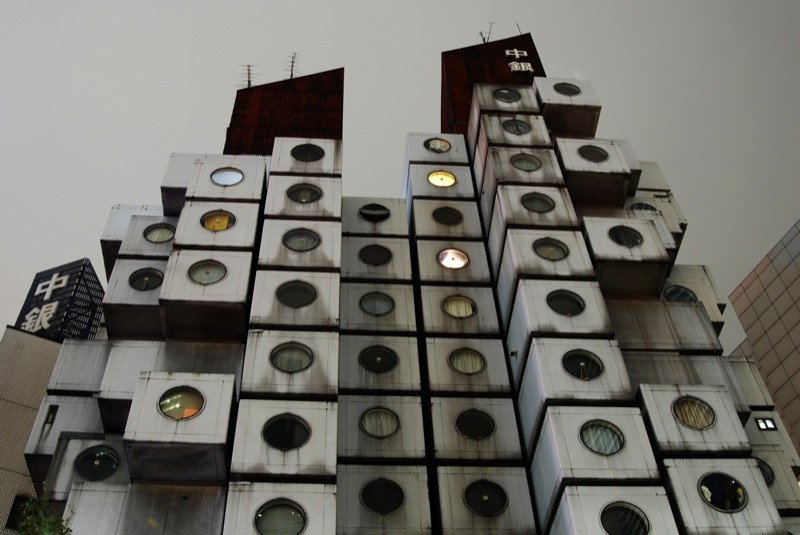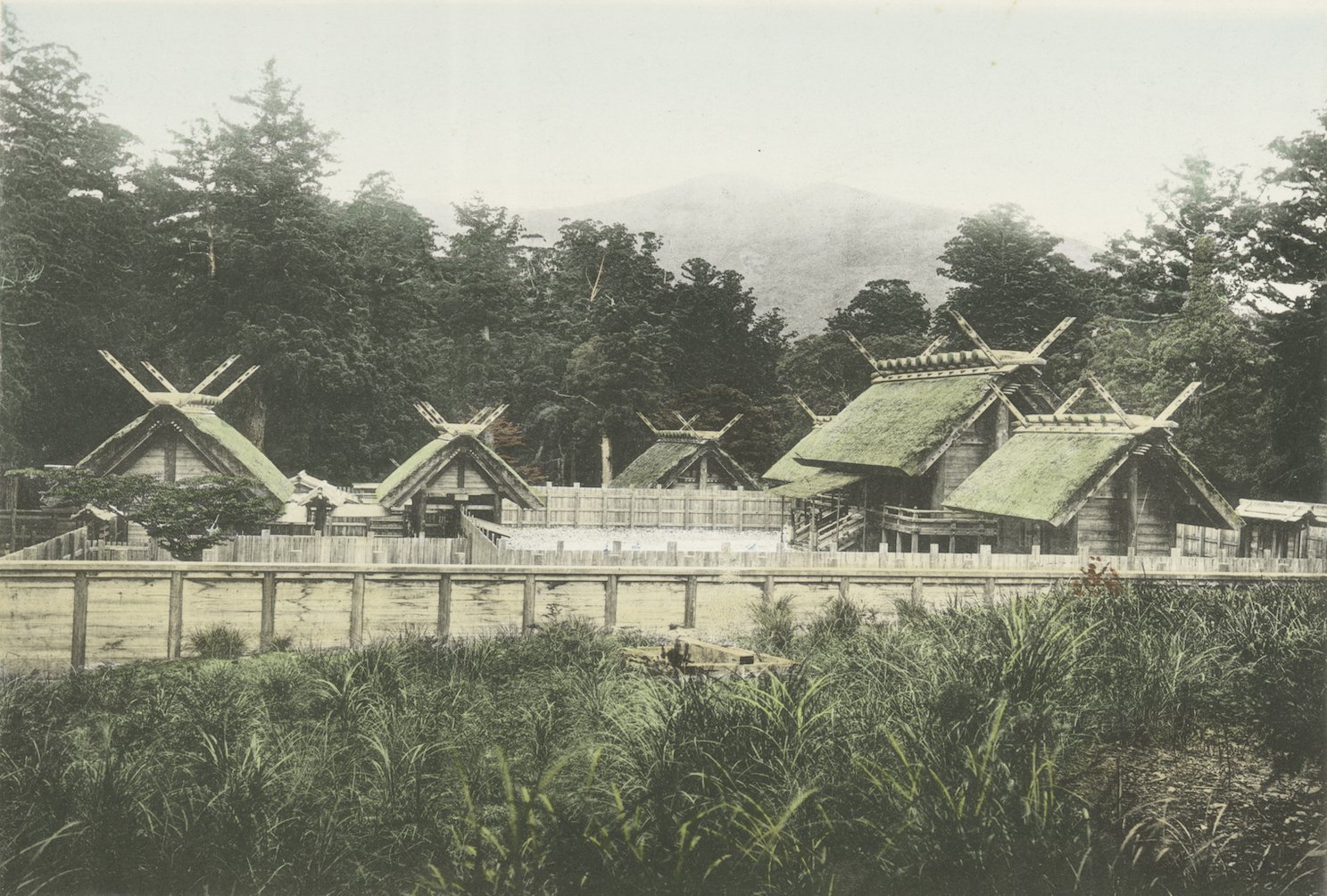
In 1972, construction workers were finishing off the last elements of a remarkable new building in Tokyo. The Nakagin Capsule Tower was a space-age construction, a tall pile of seemingly random arranged concrete boxes, each perforated by a single porthole window, rising above the crowded streets of Ginza like a Brutalist stack of Lego.
The following year, workers began dismantling the wooden structures of the Grand Shrine of Ise, a couple of hundred miles to the west of Tokyo. One of Shinto’s most sacred places, the shrine is set in a forest and dedicated to the sun goddess Amaterasu. Its buildings are taken down and rebuilt every 20 years as a way of passing knowledge and skill from one generation of craftsmen to the next, a custom embodying a belief known as tokowaka, or a kind of pursuit of eternity through the transition of ritual and skill.
They are both a part of a particularly Japanese conception of the nature of architectural fabric, which can seem somehow simultaneously very seductive and very alien to those of us who have grown up in a Western tradition. Here we are soaked in a cult of the fabric, of the authentic, of an idea of the material of a building somehow encapsulating the history it has witnessed. In Japan, it is not so much the material that matters but the process: the skills, the rituals, the embodiment of the knowledge of construction. The history is entwined with the handicraft, and it is the perpetual newness and pristine condition of the building that illustrates eternity, not the traces of its wear and decay.
The Nakagin Capsule Tower survived for half a century—not bad for Tokyo. It became the emblematic building of a movement known as Metabolism, a Japanese phenomenon that blended ideas about buildings and the body. Elements would be renewed like cells, tissue, and muscles around an armature to enable it to develop and adapt over time, with modernist notions of the expression of function through form and the enthusiastic adoption of new, prefabricated construction techniques.
Designed by Kisho Kurokawa in 1970, the Nakagin tower sought to accommodate Tokyo’s salarymen during the week, a stack of bachelor pads providing minimal apartments for the few hours of sleep allowed them between their ruthless workdays. The 140 prefabricated, self-contained capsules came equipped with all mod-cons including, for a slight uplift in rent, a built-in stereo. The interiors were tiny but efficient, with a bathroom pod (with a bath, although the toilet actually stood in it), a bed beneath the round window, and a pull-out desk.
By the early 2000s, the tower had fallen into disrepair, with most capsules empty. It had become a kind of tourist oddity, a cult among architects but also the target of redevelopment plans fought vociferously by conservationists, art historians, and architects across the world. The best they could do was to preserve 23 of the original 140 capsules, a number of which have found eager hosts with institutions and museums. It was also comprehensively mapped using 3D scanning technology, which is, arguably, a more perfectly appropriate Japanese method of preservation.
Metabolism, which was launched in 1960 (with Kurokawa as one of its founders and Kenzō Tange and Yoshio Taniguchi among its most influential adherents) might be seen as a particular cultural response to a number of factors. There was the widespread techno-industrialization of Japan as the world’s leading technological manufacturing base, and the devastating destruction of its cities in the American bombing of the Second World War. And there was the curious continuity of understanding architecture as a layer of replaceable and expendable elements within a larger framework, embodied by the traditional timber and paper houses, for instance, which were only ever meant to last a relatively short period.
But this became a resilient and globally influential idea. You can see its impacts in the prefab structures of offshore oil platforms and accommodation rigs in the world’s oceans, and in the forms of Richard Rogers’s Lloyd’s Building in London. You can see it in the relentless mania for emergency structures made using shipping containers, and in budget hotels and housing still being produced as prefab capsules.

Meanwhile, the Ise shrine, its architecture derived from the elemental agricultural forms of ancient rice barns, privileges not the fabric but the embodied skills of carpenters. No power tools are allowed on the sites of the shrines, so all techniques involve complex traditional jointing—no nails. It is as anti-tech as the Metabolists were tech fetishists.
And while capsulization aimed for a kind of universality (its logical end point was a transportable, factory-made unit), the carpentry techniques and details used at the shrine were forbidden elsewhere. It was a knowledge that remained deliberately specific to its place, though not its time.
The fates of both structures, one demolished but part preserved and dispersed, the other consistently rebuilt over centuries—it is on its 62nd cycle of rebuilding (though no one knows exactly how many have occurred) and the techniques appear to date back 2,500 years—exemplify the inconsistencies in contemporary notions of heritage and permanence, of authenticity and function.
It is probably not very widely understood that very little of the material constituting the great cathedrals of Europe is actually medieval. These are buildings that have been repaired and rebuilt; suffered through war, wear, and weather; and adapted and remodeled over centuries. Yet we look upon them as mighty, immovable, and sacred objects, their fabric as sacred as their ritual use, with every contemporary repair fanatically considered and controlled.
The parable of Theseus’s ship haunts our material history. The vessel is battered and worn, and constantly repaired and rebuilt, so that, ultimately, none of the original material remains of the ship that Theseus had built—and yet there Theseus’s ship still is. It creates a conundrum, a philosophical problem about the value of material that might have been touched by mythical hands from history, shaped by another age.
For the woodworkers and thatchers at the Ise shrine, there is no paradox. They are the history. And their successors, their sons and apprentices, will be, too. The complex and lengthy rituals that accompany the finishing of each stage of the work are as important as the work itself. It acknowledges an almost Ruskinian reverence for work, an appreciation of labor rather than, necessarily, the artifact.
The idea of a rebuildable object also shines through the widespread adoration of kintsugi, an appreciation of imperfection in which the medium is the bonding agent for the broken pieces of an object. In this traditional Japanese technique, the work of repair is fetishised over the original appearance of the artifact. Where these various fetishes fall down, however, is at home.
So what of the home? Where is the domestic kintsugi? The celebration of imperfection and repair? With the exception of repurposed industrial buildings and lofts (an upper middle-class affectation that chimes with art space and an idea of tasteful authenticity for downtowns, which now exclude everyone but the wealthy) residential designers and clients are still seduced by the idea that, at home, things should be as perfect as possible, reluctant to acknowledge the ravages of time and the traces of history and use, even in old houses. There is a certain pleasure in the uncovering of a historic fireplace or cornice—but these are often then fanatically restored and made new.
What, then, of new buildings? Might there be a world in between, in which materials and artifacts have their own history—so that no new home is a tabula rasa? Materials are a tricky issue. A huge source of embodied carbon and labor, it is something architecture needs to confront but the construction industry remains unwilling as it adds an extra layer of difficulty, of sourcing and testing, supply and reliability.
One unusual and intriguing cooperative design practice, ROTOR in Belgium, with a huge yard in Brussels, has been doing what it can to create a materials bank and research the reuse of materials. Slabs of marble cladding, midcentury floor tiles, 1960s office furniture, art deco bathroom fittings, and huge quantities of perfectly good doors occupy the huge warehouses, all digitally labeled and cataloged for reuse. Architects enjoy the history of these materials, in their quality but also in that intangible sense of having already lived a good life. This is the Metabolism of today, the changing and adoption of buildings through elements, but old rather than new.
On a smaller scale, we could all be doing this. It is undoubtedly more difficult and time-consuming. It might even be more expensive. But the result will be an interior with depth, a home imbued with rich layers of both material and time.
The future belongs neither to the Nakagin or to Ise. Both are too predetermined. Instead, perhaps, it might belong in a more ad hoc tradition of scavenging and foraging. Few of the young people I meet today are interested in big-brand fashion or label shopping; they instead spend their time in thrift stores or online, on vintage-clothes platforms. The search is part of the pleasure.
Could this be a future for architecture? An acknowledgment that too much is being made, and that it might be more individual and interesting to collage an architecture from found objects? Theseus’s ship had no original material, but it remained Theseus’s ship. How might we reuse and recycle existing material to continue creating and adapting new architectures and new homes? What wonderful kind of ship might those become?